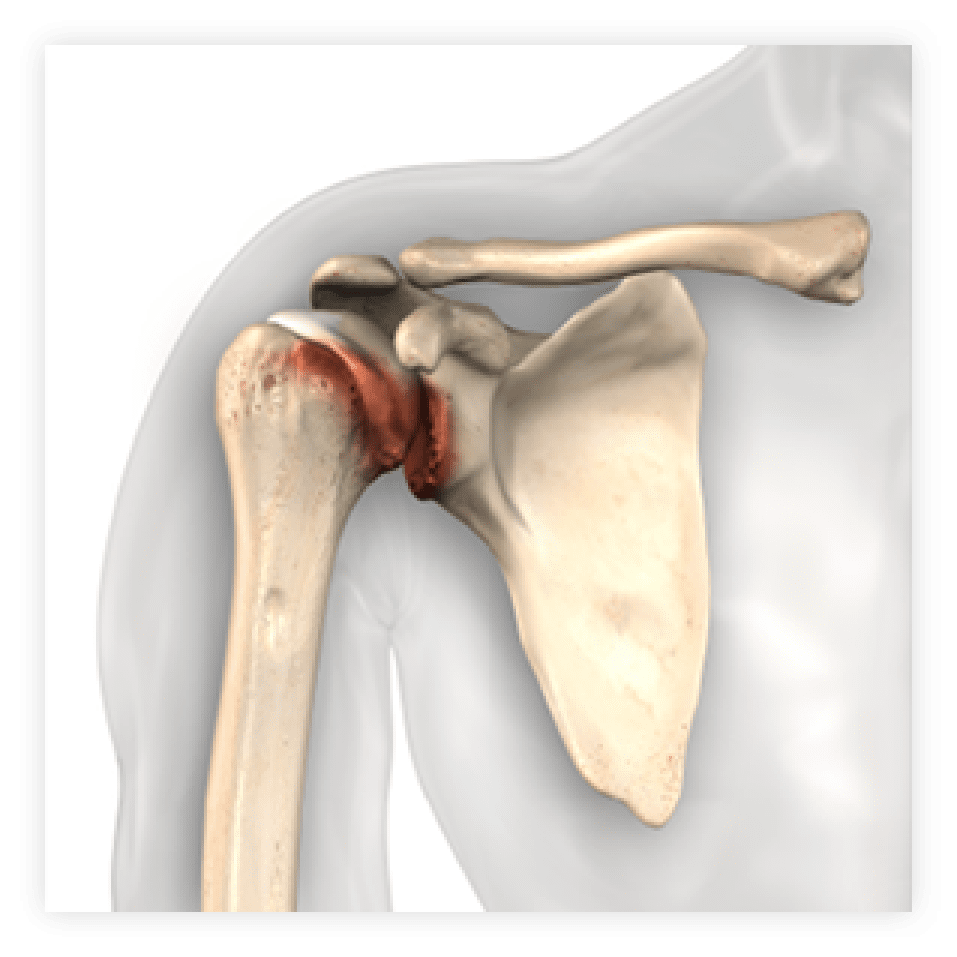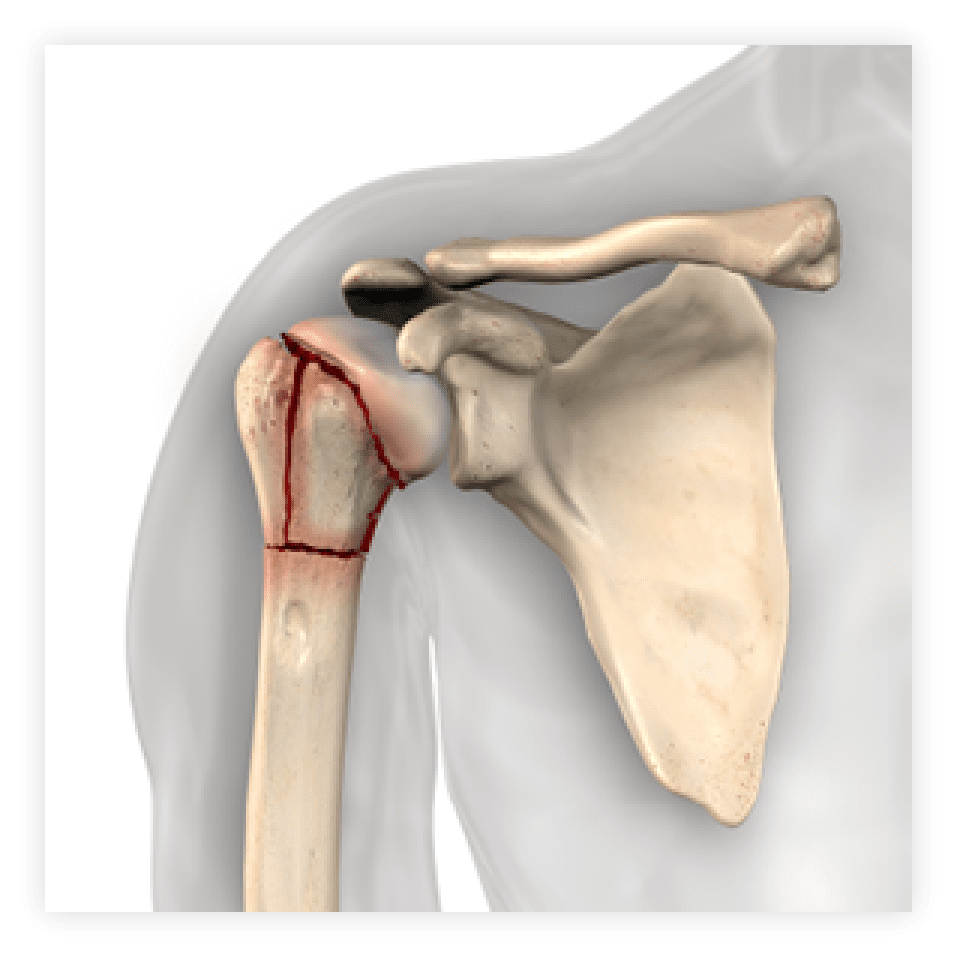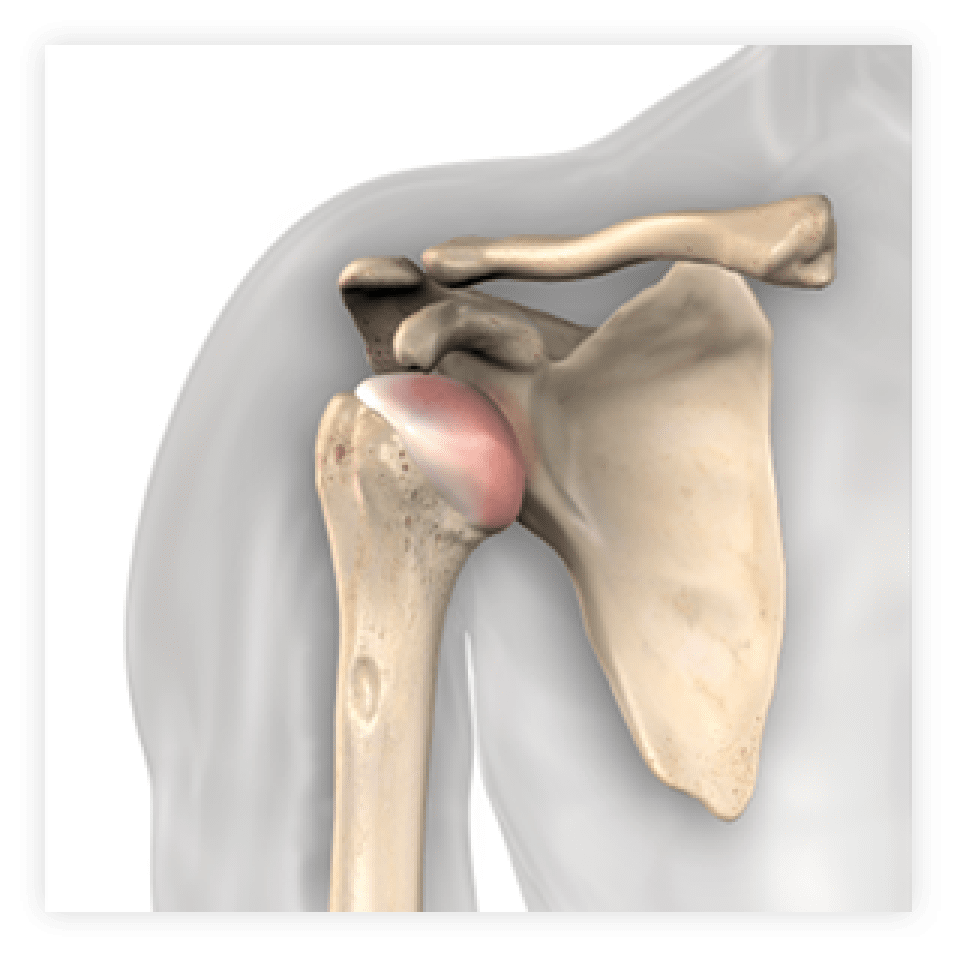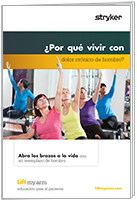What's causing your pain?
Arthritis
Arthritis causes the cartilage – the smooth tissue covering bones – to break down. When the cartilage breaks down, the ball and socket of the shoulder joint rub against each other, which is painful, causes swelling, and limits your range of motion. There are many types of arthritis, the most common types affecting the shoulder are osteoarthritis, post-traumatic arthritis, and rheumatoid arthritis. When pain and lack of mobility reaches an advanced stage, shoulder replacement may be recommended.
Osteoarthritis (OA), the most common form of arthritis associated with shoulder pain, can be caused by wear-and-tear over time or can develop years after an injury, like a dislocation.1 Symptoms may include stiffness in the shoulder on waking, pain in the shoulder during or after movement or exercise, or a crunching sound or feeling when moving the shoulder. Symptoms may worsen progressively over time.
Rheumatoid Arthritis (RA) is an autoimmune disease in which the body’s own immune system attacks joint tissue causing inflammation that damages and breaks down the cartilage, leaving bone rubbing on bone. Symptoms may include pain, swelling, and stiffness in multiple joints, and stiffness in the shoulder on waking that doesn’t go away. RA may also appear as symmetrical symptoms (symptoms in both shoulders). Symptoms may appear suddenly and get worse over a few weeks.

Torn rotator cuff
Rotator cuff tears are common, and are more likely to occur after age 40. As we age the tendons that make up the rotator cuff weaken and are more likely to tear during a fall, when pulling or lifting with force, or during repetitive overhead activity such as painting, swimming, and weightlifting. When a torn rotator cuff is not repaired, the shoulder doesn’t move the way it should which causes wear and tear on the joint.
Over time, injury to the rotator cuff muscle or muscles, can lead to changes in the bone and surrounding tissue, limiting your movement and making your arm feel weaker.2
This condition is referred to as cuff-tear arthropathy. Symptoms may include pain in and around the shoulder, pain when lifting or rotating the arm, and pain that gets worse at night and when sleeping on the affected shoulder. A reverse shoulder replacement is often recommended for large rotator cuff tears that can’t be repaired and in cases of rotator cuff-tear arthropathy.

Avascular Necrosis (AVN)
Avascular Necrosis (AVN) occurs when normal blood supply doesn't reach the ends of the bone to keep them healthy. As bony matter dies, the ends of the bones weaken, sometimes collapsing, damaging some of the surrounding cartilage and soft tissue with it. AVN can affect the shoulder joint, most commonly at the top end of the long upper arm bone, the humerus.3
Shoulder fracture
A shoulder fracture can be caused by a fall on the shoulder, car accident, or contact sports, and involves at least one of the three shoulder bones: scapula (shoulder blade), clavicle (collar bone), or humerus (upper arm bone).
Proximal humerus fracture
The most common type of shoulder fracture is a proximal humerus fracture–a break in the “ball” of the shoulder
joint at the top of the upper arm bone. Although proximal humeral fractures can occur at any age, they are more
common in older individuals due to poor bone density (osteoporosis), and may occur as the result of a low-impact fall
on an outstretched arm. Symptoms may include pain in the shoulder, swelling and numbness in the affected arm, and
limited shoulder movement. You may be unable to raise the affected arm.

Shoulder dislocation
Shoulder dislocations commonly occur because of a fall. An outstretched arm positioned to "catch" the fall can force the top of the humerus or “ball”, to shift out of the socket and towards the front of the body. A person is at an increased risk of having more dislocations after the first one occurs. The rotator cuff may tear when the dislocation occurs; shoulder replacement may be recommended if the rotator cuff is irreparable or completely torn.

Find out why your shoulder hurts.

What will a doctor do?
Every doctor is different, but many follow a similar approach to helping you understand your shoulder pain. At your first appointment, your orthopaedic doctor will ask you a few questions about when and where your shoulder hurts to assess what’s going on. The doctor may understand what’s going on right away because you show classic symptoms of a particular problem. The doctor may also ask you to have an additional diagnostic test, like an X-ray, CT-scan or an MRI.
Pain relief doesn’t always mean surgery. Your doctor may recommend a combination of treatments to alleviate your pain and help you get moving again – perhaps a course of physical therapy, rest, ice, or over-the-counter anti-inflammatory medication. If you have pain in your chest that radiates down your arm, or if you have severe pain, swelling, or discoloration, seek emergency medical treatment.
One out of every four adults has some form of arthritis.1
References:
- The Arthritis Foundation. What is Osteoarthritis. https://www.arthritis.org/about-arthritis/types/osteoarthritis/.
- Rotator cuff tear arthropathy: evaluation, diagnosis, and treatment: AAOS exhibit selection. Bone Joint Surg Am. 2012 Mar 21;94(6):e34. dos: 10.2106/JBJS.K.00746. Nam D, Maak TG, Raphael BS, Kepler CK, Cross MB, Warren RF. https://www.ncbi.nlm.nih.gov/pubmed/22438007.
- The Mayo Clinic. Dislocated Shoulder. https://www.mayoclinic.org/diseases-conditions/avascular-necrosis/symptoms-causes/syc-20369859.
Shoulder replacement
Anatomic total shoulder joint replacement is intended for use in individuals with painful, disabling joint disease of the shoulder resulting from: degenerative arthritis, rheumatoid arthritis or post-traumatic arthritis. Additional indications could include but not limited to: aseptic necrosis of the humeral head, proximal humeral fracture and revision of previous unsuccessful hemiarthroplasty or other procedures.
Reverse total shoulder joint replacement is intended for use in individuals with a functional deltoid muscle and with massive and non-repairable rotator cuff tear with pain disabled by: rheumatoid arthritis, non-inflammatory degenerative joint disease, humeral head fracture, traumatic arthritis and revision of devices if adequate bone stock remains.
Shoulder joint replacement surgery is not appropriate for patients with any active or suspected latent infection in or about the shoulder joint, any mental or neuromuscular disorder which would create an unacceptable risk of prosthesis in stability, prosthesis fixation failure or complications in postoperative care. Additionally, shoulder joint replacement surgery is not appropriate for patients whose anticipated activities would impose high stresses on the prosthesis and its fixation.
As with any surgery, shoulder joint replacement surgery has serious risks which include, but are not limited to, pain, infection, intraoperative complications, component wear, nerve damage, loosening of shoulder components and dislocation of the shoulder prosthesis.
Implant related risks which may lead to a revision or removal of the implant include being overweight, manual labor activities, some sports activities, patient age, activity level, medical conditions, alcohol or drug addiction, and mental disorders. Shoulder joint implants may not provide the same feel or performance characteristics experienced with a normal healthy joint
The information presented is for educational purposes only. Speak to your doctor to decide if joint replacement surgery is appropriate for you. Individual results vary and not all patients will return to the same activity level. The lifetime of any joint replacement is limited and depends on several factors like patient weight and activity level. Your doctor will counsel you about strategies to potentially prolong the lifetime of the device, including avoiding high-impact activities, as well as maintaining a healthy weight. It is important to closely follow your doctor’s instructions regarding post-surgery activity, treatment, and follow-up care. Ask your doctor if a joint replacement is right for you.
This site is for visitors from the United States.
Stryker Corporation or its divisions or other corporate affiliated entities own, use or have applied for the following trademarks or service marks: Blueprint, ReUnion, Simpliciti, Shoulder iD, Stryker, Tornier. All other trademarks are trademarks of their respective owners or holders.
Copyright © 2024 Stryker
OT-AWI-53 Oct-2023

